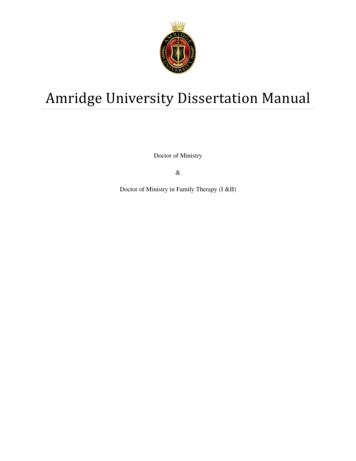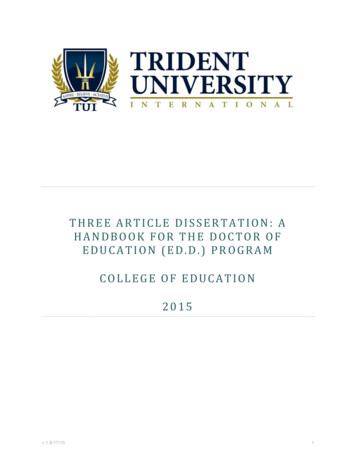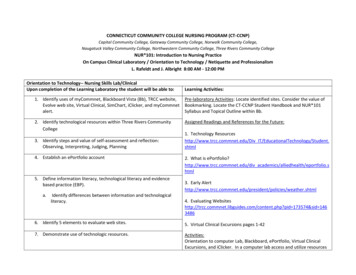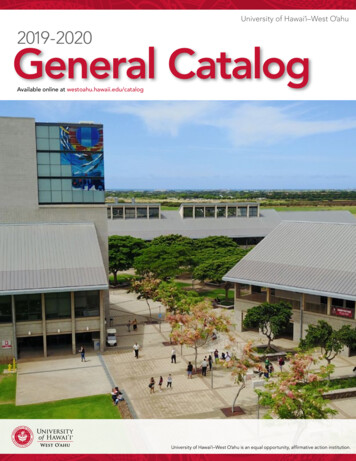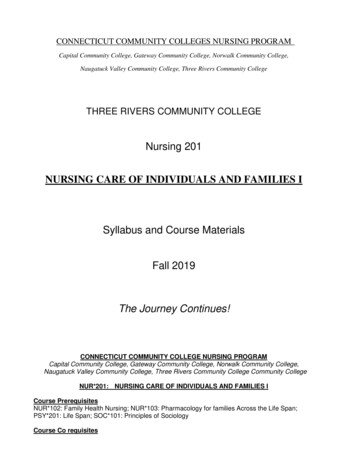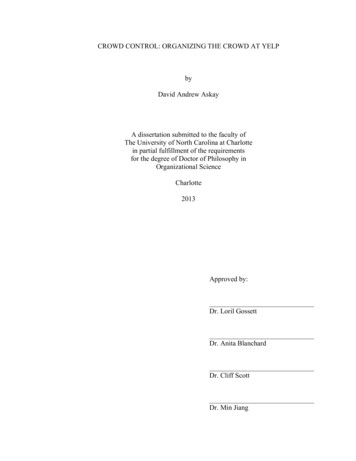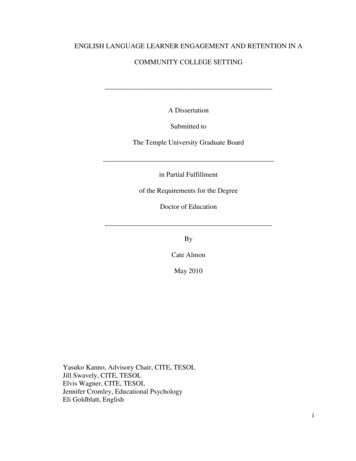
Transcription
ENGLISH LANGUAGE LEARNER ENGAGEMENT AND RETENTION IN ACOMMUNITY COLLEGE SETTINGA DissertationSubmitted toThe Temple University Graduate Boardin Partial Fulfillmentof the Requirements for the DegreeDoctor of EducationByCate AlmonMay 2010Yasuko Kanno, Advisory Chair, CITE, TESOLJill Swavely, CITE, TESOLElvis Wagner, CITE, TESOLJennifer Cromley, Educational PsychologyEli Goldblatt, Englishi
ABSTRACTEnglish Language Learner Engagement and Retention in a Community College Settingby Cate AlmonDoctor of EducationTemple University, May 2010Major Advisor: Dr. Yasuko KannoThis multi-method study explored English Language Learner (ELL) enrollmentand engagement in a community college to address a dearth of research on ELL retentionin this context. Quantitative analyses were performed on four fall semester transcripts ofELLs (N 161) and on samples of ELLs and non-ELLs (n 139) matching in age,enrollment status, and race/ethnicity. Quantitative analyses were also performed on TheCommunity College Survey of Student Engagement (CCSSE) instrument for another setof ELLs (N 45) and matched samples of ELLs and non-ELLs (n 34). Qualitativeanalyses of interviews with a third set of ELLs (N 28) were also conducted.Results suggest that ELLs overall do well as implied by their high GPAs and engagementscores, yet most do not persist long enough to complete the ESL program or graduate.GPAs were well above the minimum for graduation (2.00) and significantly higher (p .05) than the non-ELLs. ELLs scored higher than the nation in all five benchmarks, andsignificantly higher than the non-ELLs in the support for learners benchmark. However,even though the majority of ELLs expressed that they wanted an associate’s degree, only43% successfully exit the ESL program and 13% graduate from the college. Thegraduation rate is significantly less (p .05) than college (23%) and nation (25%).Toexplain, certain groups presented higher risk. Students who began in lower levels of ESLii
were five times less likely to complete the ESL program (p .05). Nontraditionally agedELLs had lower GPAs, persisted fewer fall semesters, and graduated less than theircounterparts (all significant at p .05). Also found were risk factors to which studentsattribute their leaving college: lack of finances, full time work, and family obligations.Interviews revealed implicit risk factors of linguistic challenges and their ELL status atthe college, both of which affected their engagement, as well as a lack of proceduralknowledge for navigating US colleges that could enable their retention. Students whopersist, graduate, or transfer attribute this success to seeking tutoring and investing extraeffort. Implications for practice and research are given.iii
ACKNOWLEDGEMENTSFirst and foremost I would like to give my sincere appreciation to my advisor, Dr.Yasuko Kanno, who believed in this project from the beginning and without whoseencouragement and support I never would have completed this journey. I also thank mycommittee members, Drs. Jill Swavely, Elvis Wagner, Jennifer Cromley, and EliGoldblatt, all of whose feedback contributed valuable insights to the interpretation of thework. I also thank Dr. Aneta Pavlenko whose teachings early in the program inspired meto make an impact. I am also indebted to countless faculty and staff at Temple Universityfor giving me direction and supporting me to acquire the crucial procedural knowledgethat I needed to persist. I also could not have gotten this far without my supportive peersin the TESOL Program, particularly Jungmi Kim and Eunsook Rhee.I thank the college where I work which supported me along the way, andparticularly Carole Collins, Jill Hirt and Kathy Kapscos. I thank members of the CCSSEorganization for use of their survey and for their guidance. I am very thankful to thestudents who were a part of this study, especially the twenty-eight who sacrificed theirvaluable time to meet and share their experience with me in interviews. I am also gratefulfor my supportive family and all my friends and loved ones, especially Jana Fritzges,Joan George, and Virginia Wilson who encouraged me all along.iv
TABLE OF CONTENTSABSTRACT. iiACKNOWLEDGEMENTS . ivLIST OF TABLES . xCHAPTER 1 . 1INTRODUCTION . 1Problem Statement . 1Introduction . 1Context of the study . 5Background . 8ELL Inquiry in Community College Research . 8A Tradition of Retention Studies at Community Colleges . 11Theoretical Framework . 12Engagement. 13CCSR . 14The Study . 16Purpose. 16Research Questions . 16Delimitations and Limitations. 19Findings. 20Structure of the Work. 23v
CHAPTER 2 .24REVIEW OF THE LITERATURE . 24ELL Studies that Focus on Retention . 24Retention Studies that Focus on Engagement . 29A Focus on Ethnic Minority Students . 30Remedial Education and Engagement . 32Obstacles to Engagement . 35CHAPTER 3 .38THEORETICAL FRAMEWORK . 38Tinto . 38Astin . 41CCSSE’s Benchmarks . 44CHAPTER 4 .47METHODS . 47Research Approach and Design . 47Methods for Retention Phase . 48Participants . 49Limitations . 52Procedure . 53Variables . 53Data Analyses . 54Methods for CCSR Survey Phase . 58Participants . 59vi
Instrument: About the CCSR Survey. 65Data Analyses . 67Methods for Interview Phase . 68Participants . 68Limitations . 72Instrument . 73Interview Analysis . 74CHAPTER 5 .77RESULTS AND DISCUSSION FOR RETENTION DATA . 77Results for ELLs . 78Comparing Graduates and Nongraduates . 81Discussion of ELL Findings . 82Results among ELL Groups by Characteristic. 85Descriptive Comparisons . 85Significant Findings . 88GPA and Enrollment . 89Program Completion and Graduation . 90Discussion of ELLs by Characteristic. 92Results between ELLs and Non-ELLs . 93Discussion of ELL and Non-ELL Comparisons . 95General Discussion . 96CHAPTER 6 .99RESULTS AND DISCUSSION FOR SURVEY DATA . 99vii
Results for ELL Retention-related Items . 100GPA. 100Goals vs. Plans .101Obstacles and Risk Factors .102Discussion of Retention Related Results .103Results for ELL Benchmark Results.105Support for Learners .106Active and Collaborative Learning .107Student Effort .108Academic Challenge .109Student Faculty Interaction .110Age Group Comparisons of Benchmarks .111Discussion of ELL Engagement Results.111Results Comparing ELLs and Non-ELLs .114Discussion of ELL and Non-ELL Comparison Results .116General Discussion .118CHAPTER 7 .122RESULTS AND DISCUSSION FOR INTERVIEW DATA .122Causes for Leaving .124Finances, Work, and Family: Reasons to Leave or Challengesto Overcome .128Finances .128Work .131viii
Family .135Concluding Remarks on Dominating Factors .138Engagement.138Active and Collaborative Learning .139Student Faculty Interaction .143Academic Challenge .144ESL .144Remedial Courses .146Content .149Support for Learners .153Student Effort .155Concluding Remarks on Engagement .162Discussion of Interview Results.163CHAPTER 8 .166CONCLUSIONS AND IMPLICATIONS .166What did we Find? .167Implications.174ESL Program .174College .176Suggestions for Future Research .180Conclusion .183REFERENCES .184APPENDICES .194ix
LIST OF TABLES3.1Outline of CCSSE’s Benchmarks .514.1. Characteristics of ELLs (n 161) and Non-ELLs(n 6968).504.2. Characteristics of Matching Samples.514.3. Chi-Square Results for ELL Characteristics between 2006and 2007 .614.4. Characteristics of ELLs (n 45).634.5. Characteristics of Non-ELLs (n 1011) .644.6. Characteristics in Matching Samples .654.7.Reliability of Benchmark Related Items for ELL Responses .674.8. Interview Participants .705.1. Descriptive Statistics for ELLs as a Group .795.2.ELL Persistence, Stop-out, and Dropout Rates .805.3.ELL Cumulative Graduation Rates from First Fall to Last Fall .815.4.ESL Program Completers and Graduates .815.5.Descriptive Statistics by Level When Entering ESL Program .855.6.Descriptive Statistics of ELLs by Their Characteristics .875.7.Demographics by Categories of Race, Residents Only(n 118).885.8.Descriptive Statistics on Subgroups by Age, Ethnicity,and ESL Level .885.9.Linear Regression Results.90x
5.10. Logistic Regression Results for ESL ProgramNon-completion .915.11. Logistic Regression Results for Non-graduation .925.12. Results for Matching ELLs and Non-ELLs .935.13. Results for Those Less Likely to Graduate, ELLs Comparedto Non-ELLs .946.1.ELL Grade Averages Reported .1016.2 . ELL Benchmark Scores, n 45 .1056.3.Benchmark 5: Support for Learners (7 items) (n 45) .1066.4.Benchmark 1: Active and Collaborative Learning(7 items) (n 45) .1076.5.Benchmark 2: Student Effort (8 items) (n 45) .1086.6.Benchmark 3: Academic Challenge (10 items) .1096.7.Benchmark 4: Student Faculty Interaction (6) .1116.8.Non-ELL Benchmark Scores (n 1011) .1146.9.Benchmark Scores between Matching Samples .1146.10. Significant Items for ELLs Over Non-ELLs withAdjustment .1156.11. Significant Items between ELLs and Non-ELLswithout Adjustment .1167.1.Interview participants with demographic characteristics .1237.1.Categories of Reasons to Stop Out or Drop Out .125xi
CHAPTER 1INTRODUCTIONProblem StatementThe community college is an important research site since more than half of thenation’s first-time college students begin their higher education there (Townsend,Donaldson, & Wilson, 2005; Miller, Pope, & Steinmann, 2005). The mission ofcommunity colleges is to provide access to education for an often academically underprepared student population at more affordable tuitions (Belcher, 1988; Dowd &Melguizo, 2008). With this mission, then the retention of the students who attend them isa pertinent issue in this area of inquiry. It would be unethical to recruit students but thenlet them fail or drop out (Engstrom & Tinto, 2008). The first aspect of the problem thatwill be addressed here is that even though community colleges play a vital role in societyby providing accessible and affordable education and training, they are not as visible asother institutions of higher education in research studies published in higher educationjournals, as documented by Townsend, Donaldson, and Wilson (2005), who conducted acontent analysis on articles published between 1990 and 2003.Furthermore, whereas there is a dearth of studies focusing on community colleges,especially on topics that are essential to them and not simply used as convenient researchsites, there are even fewer studies on English Language learners (ELLs), students whobegin college by taking English as a Second Language (ESL) courses. ELL issues shouldbe part of the discussion on community college retention for at least two reasons. First,community colleges tend to enroll more ELLs than four-year institutions since thecommunity college offers programs aimed at helping new immigrants in the community1
as well as college bound students who still need to hone their academic English levels(Kuo, 1999). ELLs also account for many first semester students who are known to belost to attrition (Maxwell, Hagedorn, Cypers, Moon, Brocato, Wahl, & Prather, 2003).Although there are numerous studies of retention at four-year institutions of highereducation, especially that illustrate the importance of student engagement (Tinto, 1993;Pascarella & Terenzini, 2005), only recently have researchers started applying similarapproaches to research at community colleges (Marti, 2009). The gap that still exists incommunity college retention literature, especially with regard to ELLs, is another side ofthe problem that my study will attempt to address.Second language learning research is not immune to this gap in ELL retentionstudies. Since SLA research has taken on more social influences of language learning (asnoted by Block, 2003), there has been some attention to a broader scope of languagelearning such as access to linguistic resources (Pavlenko, 2000). However, there is littleattention to what happens to learners after they gain initial access into an ELL program.One research report that did look at ESL community college retention, conducted twodecades ago, showed stark figures in persistence (Belcher, 1988). Not only were ELLsless likely to graduate than students who had not started in ESL, a mere 16% finished theESL program with a grade point average (GPA) of 2.00 or higher. However, causesbehind these findings were not explored. Since then, there have been a scattering ofstudies that address ELL retention in community colleges, but that provide only pieces ofthe whole retention picture. In the following introduction, I will discuss the significanceof this study by showing how it will add to the previous work on retention in communitycolleges, and by illustrating another way to broaden the scope of ELL inquiry.2
Using multiple data sets, I used a mixed method approach to the study of ELLstudent engagement and ELL student retention in East Penn Community College (EPCC,a pseudonym). The terminology used throughout this study is explained as follows. ESLis often the term given to community college programs that teach English languagelearners and will thus be used interchangeably with ELL. Engagement here will bedefined in terms of student involvement in activities that have been associated withhigher retention rates and GPAs in college. These activities include putting effort intotheir studies, feeling challenged by coursework, seeking support, and interacting withpeers, faculty and staff. The term involvement had been used for this concept by theoristsin retention literature (Marti, 2009), but engagement is the term adopted by theorganization, Community College Survey of Student Engagement (CCSSE) whichprovided the survey used in the present study, the Community College Student Report(CCSR), and thus will be the term of choice when discussing the concept. Engagementwill be operationalized here by the activities of students and other individuals at thecollege (faculty, staff, and peers) categorized in five CCSSE benchmarks: active andcollaborative learning, student effort, academic challenge, student-faculty interaction, andsupport for learners (CCSSE, 2003c). It is argued that the positive outcomes of thisengagement include persistence in college enrollment from semester to semester, highergraduation rates, and higher GPAs. Retention is an umbrella term that is used broadly torefer to the body of literature that looks at students remaining in college and not lost toattrition. Persistence will be used to mean continuing in college from one semester to thefollowing semester.3
The study occurred in three phases using a different set of data for each phase. Inthe first phase, using quantitative measures, I examined overall enrollment trends of firsttime freshmen (FF) ELLs who began at the college in the fall semesters 2001-2004. FirstI looked at ELL students by level to see whether there were differences in number ofsemesters persisted, ESL program completion, graduation rates, and GPAs between ELLswho began in the higher versus the lower levels. I also looked for patterns indemographic data. I then compared the persistence, graduation rates (i.e. completing anassociate’s degree, certificate, or specialized diploma), and GPAs of students who begantheir first semester in the ESL Program to the rates of FF at EPCC as a whole.The second phase of the study explored student engagement of a different set ofELL participants at the same college. I examined the self-reported engagement practicesof ELL responses to the items and then compared them with non-ELL responses byanalyzing results of the standard survey instrument, the CCSR, of students enrolled andsurveyed in 2006 and 2007.Finally, a qualitative approach was taken aiming to link the first two phases.Interviews were conducted with a different sample of students, except for four studentsfrom the retention data, who either dropped out before, persisted through, or transferredout of two thresholds: completion of the ESL program in 2008 and graduation at thecollege over the course of a five-year period. Participants were asked to explain in theirown terms their experience of what influenced them to either remain in college or not.The purpose of this design was to explore the retention and engagement of ELLsby comparing ELLs and non-ELLs in their academic journeys and potential causesreflected in the CCSR survey instrument, both through quantitative measures, and then to4
get a deeper look at ELL students’ voices at possible reasons for individuals’ decisionsabout persisting in college through interview analysis. The comparisons between ELLsand non-ELLs are not made to use non-ELLs as the ideal model, especially since in somecases ELLs outperformed non-ELLs. Rather, comparisons shed light on associationsbetween engagement and retention; even though they are different groups of data (forretention and engagement) the student demographics at the college and the ESL programhave been fairly consistent over the years, so if one group has consistently strongerretention and higher engagement throughout the data, it is possible that there is a linkbetween them, a link that will be explored more directly in the interviews with individualcases. The implications of these results can assist advisors, instructors, and administratorsto look for early warning signs of attrition and develop ways to intervene and helpstudents continue learning advanced English or obtain a college degree, either of whichincreases the chances for their other potential goals such as gainful employment (Ignash,1995).Context of the StudyThe study took place at EPCC which has both noncredit free ESL courses as wellas a four-level credit ESL program. The credit program will be the research site in thisstudy since its purpose is to prepare students mostly for credit academic programs. Thestudents in a given semester represent 35 countries of origin and about 28 languages,although Spanish is spoken by about 40% of the students. About 20% of the studentscome with international student visas, and the rest are recent immigrants or immigrantswho spent a portion of their K-12 education in North America, often called generation 1.5(Harklau, 2000). Ages have ranged from 17 to 65 years.5
For the most part, students self-select into the ESL program. EPCC is consideredan open enrollment college, meaning their admissions process is not selective, except fora few programs such as nursing program. This also means that student may stop out bytaking time off and reenrolling again at a later time. However, the college requiresstudents to take placement tests for math, English, and ESL. There is no policy thatrequires ELLs to take ESL rather than remedial courses (which are explained below) ifthey do not pass the college English placement test (EPT) for native speakers and placeinto the mainstream college writing course, “English I.” However, if a student scores verylow on the EPT and answered that their first language (L1) is not English, the advisingstaff may ask them if they know about and may be interested in ESL. Remedialinstructors also look for students who may benefit more from ESL and make referrals. Ina few cases ELLs take remedial reading or writing courses after they complete the ESLprogram since they still have to pass the EPT at the end of the final level of ESL.Conversely, students are not required to complete the ESL program and may test out ofESL at any time by taking and passing the EPT.At the time of the study, there were three remedial English courses: Basic English,a pre-college writing course, and Reading Fundamentals and Critical Reading, which aretwo levels of courses that focus on instructing reading comprehension. Most ELLs passthe EPT after finishing ESL, but the ones who do not pass usually take either CriticalReading or Basic English. Any st
Temple University, May 2010 Major Advisor: Dr. Yasuko Kanno This multi-method study explored English Language Learner (ELL) enrollment and engagement in a community college to address a dearth of research on ELL retention in this context. Quantitative analyses were performed on four fall semester transcripts of
